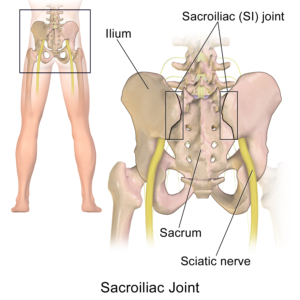What is Sacroiliac Joint Pain?
- The sacroiliac joint is in the low back where the spine meets the pelvis
- When the cartilage is damaged or worn away, the bones begin to rub on each other
- Degenerative arthritis occurs commonly in the SI joint
 The sacroiliac joint is in the low back where the spine meets the pelvis. Sacroiliac joint pain is discomfort in this area. This pain is a symptom that may come from a number of conditions or diseases.
The sacroiliac joint is in the low back where the spine meets the pelvis. Sacroiliac joint pain is discomfort in this area. This pain is a symptom that may come from a number of conditions or diseases.
As with most other joints in the body, the SI joints have a cartilage layer covering the bone. The cartilage allows for some movement and acts as a shock absorber between the bones.
When this cartilage is damaged or worn away, the bones begin to rub on each other, and degenerative arthritis (osteoarthritis) occurs.
This is the most common cause of SI joint dysfunction. Degenerative arthritis occurs commonly in the SI joints, just like other weight-bearing joints of the body.
Our Treatment Approach
We always begin treatment with the most conservative approach. Talk with your doctor about the best treatment plan for you.
Your doctor may recommend one or more of the following:
- Medication
- Treatment depends on the cause of the pain. Any underlying condition would receive treatment specific for that disease.
- Regardless of the cause, short-term rest is often advised.
- Over-the-counter pain relievers, such as acetaminophen or other nonsteroidal anti-inflammatory drugs (NSAIDs)
- Prescription pain relievers
- Muscle relaxants
- Steroid injections into the sacroiliac joint
Physical Therapy may include:
- Exercises to stretch the muscles of the lower back
- Exercises to strengthen the muscles which support the area
- Exercises to affect the motion of the sacroiliac joint
- Applying ice to the painful area
- Applying deep heat to the sore area
Causes
A Sacroiliac Joint Pain can be caused by:
- Twisting, bending, or moving in a way that triggers sacroiliac joint pain
- Osteoarthritis of the joint, which is more common in older adults
- Trauma, such as an auto accident
- Stress fractures, which is common in athletes
- Pregnancy
- Inflammation of the joint, which can occur with ankylosing spondylitis
Symptoms
Your symptoms may vary but could include:
- Mild-to-severe low back pain
- Pain in the buttocks
- Pain that seems deep in the pelvis
- Pain in the hip or groin or back of the thigh
- Pain that radiates down the leg on the affected side
- Stiffness of the lower spine
- Certain activities may increase the pain, such as walking, twisting, or bending.
You may experience sacroiliac (SI) joint pain as a sharp, stabbing pain that radiates from your hips and pelvis, up to the lower back, and down to the thighs.

